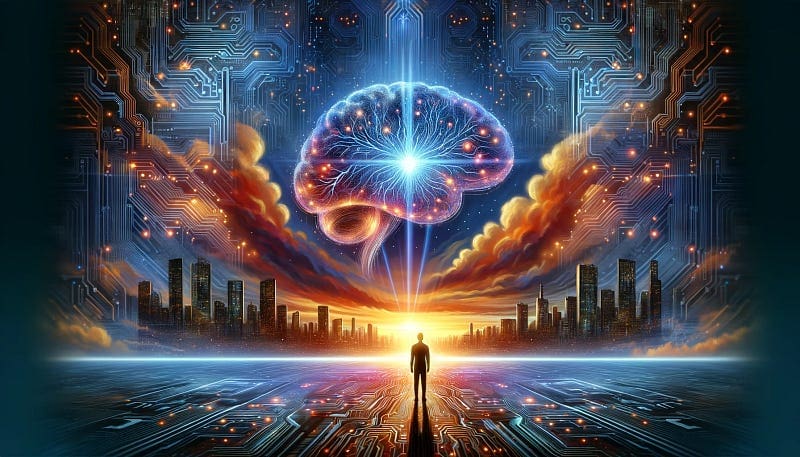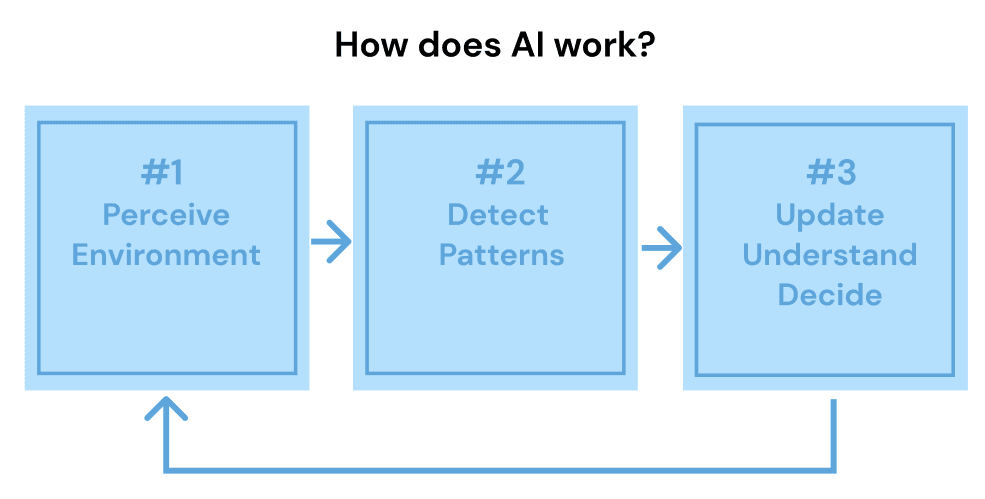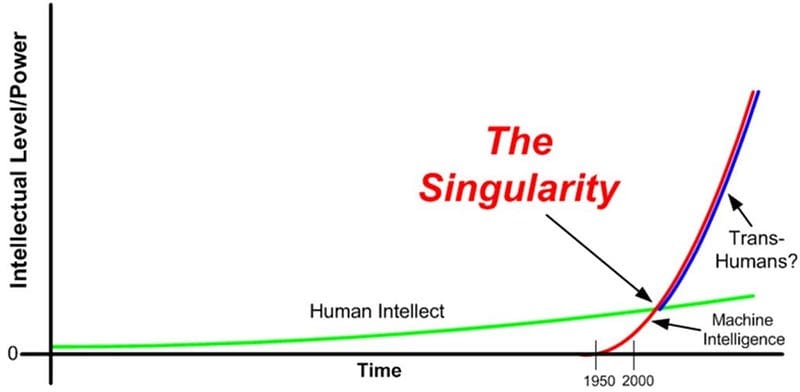
Image by Dall-E
In a world where technology is rapidly evolving, one topic stands out, capturing the imagination of scientists, tech enthusiasts, and the general public alike:
The rise of Artificial Intelligence.
As we stand before a new era, the question looms large:
What does the future hold for AI?
Stay with me and let’s discover it all together!
AI has already come a long way, from simple rule-based algorithms to deep learning models that mimic human cognition in solving problems and making decisions.

Image by Author
AI technologies are categorized into three main groups according to their ability to mimic human traits.
1. Artificial Narrow Intelligence (ANI) or AI with specialized abilities
ANI often known as weak AI or narrow AI, focuses on specific applications or tasks. It is designed to execute single tasks and tries to imitate human actions within a confined range of variables, limits, and scenarios.
Examples of ANI are prevalent in technologies like Siri’s speech and language processing on iPhones or the visual recognition capabilities in autonomous vehicles.
2. Artificial General Intelligence (AGI) or AI equal to human-level
AGI also known as strong AI or deep AI, refers to machines’ capability to understand, learn, and use intelligence to address complex issues similarly to humans. AGI operates on a ‘theory of mind’ framework, enabling it to perceive emotions, beliefs, and thought processes in other intelligent entities.
AGI remains a theoretical concept but has garnered significant interest from major tech firms. Microsoft, for instance, invested $1 billion in AGI through OpenAI. Today we already have ChatGPT-4, with its ability to tackle a wide range of problems and demonstrate higher-level cognitive skills, representing an early form of AGI.
3. Artificial Superintelligence (ASI) or AI exceeding human intellectual capacity
ASI represents a form of AI that exceeds human intellect, capable of outperforming humans in every task. ASI is not just adept at comprehending human emotions and experiences, it is also envisioned to possess its own emotions, beliefs, and desires.
While ASI is currently a theoretical concept, its anticipated decision-making and problem-solving skills are projected to be vastly superior to human abilities.
Before deep-diving into this super intelligence, let’s try to remember a bit…
The concept of AI has oscillated between fear and fascination for years, predating the actual term. The prevailing belief was that true AI had to mirror human forms, obscuring the reality that AI had been operational for quite some time.
Notable achievements, like surpassing human skills in games such as chess, were just the tip of the iceberg. Since the 1980s, AI has been a key component in various industries.

Garry Kasparov playing against Deep Blue, the chess-playing computer.
The 1990s witnessed a transformation in machine learning with the advent of probabilistic and Bayesian methods. These advancements laid the groundwork for some of today’s most prevalent AI applications, including the ability to navigate massive data sets.
This capability extended to performing semantic analysis of raw text, enabling web users to effortlessly locate desired information among billions of web pages by entering simple queries.
Super-intelligence isn’t just about crunching numbers at lightning speed. It’s about a holistic enhancement in every facet of intelligence, from reasoning and creativity to self-improvement.
Imagine a world where machines innovate, think, and learn at levels beyond human capabilities. We are not still in such a world, but as our technology evolves, this scenario might be closer than we think.
Recent advancements, such as OpenAI’s GPT-4, showcase the rapid progress in AI. Considering all the breakthroughs experienced in fields such as machine learning or quantum computing, the emergence of super-intelligence is becoming increasingly plausible.
And this brings us to…
The benefits of super-intelligence are boundless. From the medical field with AI-based disease predictors to finances or climate change, a hypothetical super intelligence could enhance human society. However, the actual AI level is already causing some big impacts, so a superintelligence could even worse these scenarios:
1. Transforming the Workplace
Forget the old idea that AI will only affect low-skilled jobs. Thanks to advancements in generative AI, like DALL-E and Mid-Journey, even creative professions are feeling the heat.
These AI systems can churn out art, literature, and videos in a flash. They’re so fast that they’re starting to outpace human journalists in writing basic news articles.
This shift is raising big questions about the future of jobs, especially in fields we once thought were safe from automation.
2. Navigating the Intellectual Property Maze
The rise of AI is stirring up a storm in the world of intellectual property. When an AI creates a song or a logo, who owns it?
- The programmer?
- The AI itself?
- The creators who provided the training data?
This issue is getting more complicated as AI systems, trained on existing content, are now capable of producing incredibly convincing fake content. This dilemma has even led to legal showdowns, like Getty Images suing Stability AI over photo usage.
3. The Misinformation Challenge
AI’s ability to create realistic, fake content cheaply and quickly is a double-edged sword. This technology could massively amplify the spread of misinformation online, a concern that’s growing as fake content becomes more sophisticated.
4. AI in Decision-Making
Governments and businesses are increasingly leaning on AI for decisions in areas like social welfare and law enforcement. These systems assign risk scores that can hugely impact people’s lives.
However, there’s a catch: unchecked AI can replicate and even worsen existing societal biases.
Humans must stay in the loop, guiding AI decisions to prevent unfair outcomes.
With great power comes great responsibility. As AI continues its rapid advancement, we need to keep up. Policymakers, industry experts, and developers need to collaborate on rules and regulations for AI.
Ensuring that these intelligent systems align with human values and ethics is paramount. Without proper checks and balances, unchecked AI could lead to dystopian outcomes, with machines potentially dominating humanity. The clock is ticking for decision-makers to craft policies that keep pace with this evolving technology.
Moreover, the equitable use and distribution of AI is a pressing concern. Super-intelligent AI could confer immense power to those who control it, leading to disparities in wealth and influence. Ensuring the beneficial and equitable use of AI is a challenge that society must address head-on.
This brings us to the…
The Singularity theory was first coined by John von Neumann in 1958. For those unfamiliar with this concept, it describes a hypothetical moment when AI either develops self-awareness or gets such advanced capabilities that they evolve beyond human control.

Image by Craig Bellamy
In this scenario, AI would improve itself autonomously at an exponential rate, far beyond human comprehension or control.
However, this concept is highly controversial.
Critics against this theory argue that it underestimates the human mind while overestimating the potential capabilities of AI. And in case this event is to happen, the timing for such event is also a subject of much debate among scientists and technologists.
So let’s not panic just yet!
The trajectory of AI’s development is promising. By adopting a balanced approach, we can harness the benefits of AI advancements while effectively addressing its challenges.
As we stand at this critical time in history, we must approach the dawn of this super-intelligence with a blend of excitement, caution, and responsibility.
How do we get ready for what’s coming?
The answer lies in raising awareness and continually educating ourselves. AI’s extraordinary capacity for automating routine tasks not only saves time but also allows humans to engage in more intricate and imaginative work.
Take healthcare, for instance: AI’s ability to interpret medical images can be life-saving. Similarly, in transportation, AI’s role is growing, evident in the popularity of self-driving cars like Teslas.
Future developments promise even more sophisticated automotive technologies. Moreover, AI is streamlining logistics and supply chains, enhancing efficiency and reducing costs.
Josep Ferrer is an analytics engineer from Barcelona. He graduated in physics engineering and is currently working in the Data Science field applied to human mobility. He is a part-time content creator focused on data science and technology. You can contact him on LinkedIn, Twitter or Medium.

